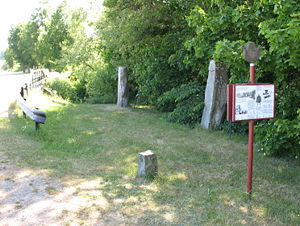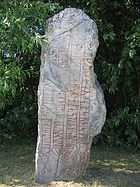
Runestones at Aspa
Encyclopedia

Runtuna
Runtuna is a locality situated in Nyköping Municipality, Södermanland County, Sweden with 268 inhabitants in 2005....
, Södermanland
Södermanland
', sometimes referred to under its Latin form Sudermannia or Sudermania, is a historical province or landskap on the south eastern coast of Sweden. It borders Östergötland, Närke, Västmanland and Uppland. It is also bounded by lake Mälaren and the Baltic sea.In Swedish, the province name is...
, Sweden
Sweden
Sweden , officially the Kingdom of Sweden , is a Nordic country on the Scandinavian Peninsula in Northern Europe. Sweden borders with Norway and Finland and is connected to Denmark by a bridge-tunnel across the Öresund....
, where a road has passed a creek since prehistoric times. One of the stones Sö Fv1948;289, below is the oldest surviving native Scandinavian source that mentions the kingdom of Sweden
Sweden
Sweden , officially the Kingdom of Sweden , is a Nordic country on the Scandinavian Peninsula in Northern Europe. Sweden borders with Norway and Finland and is connected to Denmark by a bridge-tunnel across the Öresund....
beside the runestones DR 344 and DR 216. Another stone Sö 137 is raised in memory of a Viking who had spent time in the west.
Tingshögen and Eriksgata
Aspa was the location of the local assemblyThing (assembly)
A thing was the governing assembly in Germanic and introduced into some Celtic societies, made up of the free people of the community and presided by lawspeakers, meeting in a place called a thingstead...
called the Tingshögen
Thing (assembly)
A thing was the governing assembly in Germanic and introduced into some Celtic societies, made up of the free people of the community and presided by lawspeakers, meeting in a place called a thingstead...
, and the newly elected king passed the stones during his Eriksgata
Eriksgata
Eriksgata is the name of the traditional journey of the newly elected medieval Swedish kings through the important provinces to have their election confirmed by the local assemblies...
. The Eriksgata was the traditional journey of the newly elected medieval Swedish kings through the important provinces to have their election confirmed by the local assemblies. The actual election took place at the Stone of Mora in Uppland. Runestones at other locations that tradition holds were associated with the Eriksgata include U 793 at Ulunda and Vg 4 at Stora Ek. Originally there were several runestones erected at the Tingshögen, but today only a few remain, and some of these were recovered from having been reused as construction materials at a bridge.
Sö Fv1948;289

Denmark
Denmark is a Scandinavian country in Northern Europe. The countries of Denmark and Greenland, as well as the Faroe Islands, constitute the Kingdom of Denmark . It is the southernmost of the Nordic countries, southwest of Sweden and south of Norway, and bordered to the south by Germany. Denmark...
. The runic text says that they were the ablest men in Sweden. The runestone was found in 1937 during trench work near a bridge and was moved adjacent to Sö 141. Originally, the stone was probably located at the Tingshögen, and later reused at the bridge.
The Rundata
Rundata
The Scandinavian Runic-text Data Base is a project involving the creation and maintenance of a database of runic inscriptions. The project's goal is to comprehensively catalog runestones in a machine-readable way for future research...
designation for this Södermanland inscription, Sö Fv1948;289, refers to the year and page number of the issue of Fornvännen
Fornvännen
Fornvännen is a Swedish academic journal in the fields of archaeology and Medieval art. It is published quarterly by the Royal Swedish Academy of Letters in Stockholm, Sweden. The journal's contributions are written in the Scandinavian languages, English, or German with summaries in English...
in which the runestone was first described.
Latin transliteration
- ostriþ : lit : -ira : ku(m)... ...usi ÷ at : anunt ÷ auk : raknualt : sun : sin ÷: urþu : ta...R : - (t)an...-...(k)u : ua-u : rikiR : o rauniki : ak : snialastiR : i : suiþiuþu
Old Norse transcription
- Astrið let [g]æra kum[bl þa]usi at Anund ok Ragnvald, sun sinn. Urðu da[uði]R [i] Dan[mar]ku, va[R]u rikiR a Rauningi ok sniallastiR i Sveþiuðu.
English translation
- Astrid had this memorial made after Anund and Ragnvald, her son. (They) died in Denmark, were powerful in Rauningi and the ablest in Sweden.
Sö 136
Runestone Sö 136 was documented during the surveys of runestones conducted in the late 17th century, but has since been lost. The inscription, however, is known from records. It is classified as having been carved in runestone style Pr1.Latin transliteration
- [: suain : iuk : sluia * þaiR : raisþu : ---... ... ...-nu * at : faþur : sin : hirsi * uksniauin ian uas : unt hifni bistr]
Old Norse transcription
- Svæinn ok Sloði(?) þæiR ræisþu ... ... ... at faður sinn, hærsi(?) hugsniallan(?). Hann vas und hifni bæztr.
English translation
- Sveinn and Slóði(?), they raised ... ... ... in memory of their father, an able-minded(?) chieftain(?) He was the best under heaven.
Sö 137
.jpg)
Staveless runes
Staveless runes were the climax of the simplification process in the evolution of runic alphabets that had started when the Elder Futhark was superseded by the Younger Futhark. In order to create the staveless runes, vertical marks were dropped from individual letters...
. In the last row all the words but the last one were written with staveless runes. Sö 137 is also considered to be one of the Viking runestones
Viking Runestones
The Viking Runestones are runestones that mention Scandinavians who participated in Viking expeditions. This article treats the runestone that refer to people who took part in voyages abroad, in western Europe, and stones that mention men who were Viking warriors and/or died while travelling in the...
. The runic inscription emphasizes that the stone was originally located at the Tingshögen.
Latin transliteration
- A þura : raisþi : stin : þ--si at : ubi : buanti : sin
- B : stain : saR:si : stanr : at : ybi : o þik*staþi : at ¶ : þuru : uar : han : uestarla : uakti : karla ¶ [sa þar] * sunr þaþ * raknasuatau(k)i(f)maR[sua]
Old Norse transcription
- A Þora ræisþi stæin þ[ann]si at Øpi, boanda sinn.
- B Stæinn saRsi standr at Øpi a þingstaði at Þoru ver. Hann vestarla væknti(?) karla, sa þaR sunR það. ...
English translation
- A Þóra raised this stone in memory of Œpir, her husbandman.
- B This stone stands in memory of Œpir, on the Assembly-place in memory of Þóra's husband. He armed(?) (his) men in the west. The son saw this there ...
Sö 138

Latin transliteration
: hiar : stainr : stin : at : kuþan : ybis : arfa : ak : þurunaR kylu : broþurs : kuþ hialbin : at :
Old Norse transcription
- Hier stændr stæinn at goðan Øpis arfa ok ÞorunnaR, Gyllu broðurs. Guð hialpin and.
English translation
- Here stands the stone in memory of Œpir's and Þórunnr's good heir, Gylla's brother. May God help (his) spirit.
Sö 141

Christian cross
The Christian cross, seen as a representation of the instrument of the crucifixion of Jesus Christ, is the best-known religious symbol of Christianity...
near the top of the inscription. The reference to bridge-building in the runic text is fairly common in runestones during this time period. Some are Christian
Christian
A Christian is a person who adheres to Christianity, an Abrahamic, monotheistic religion based on the life and teachings of Jesus of Nazareth as recorded in the Canonical gospels and the letters of the New Testament...
references related to the soul passing the bridge into the afterlife. At this time, the Catholic Church sponsored the building of roads and bridges through the use of indulgence
Indulgence
In Catholic theology, an indulgence is the full or partial remission of temporal punishment due for sins which have already been forgiven. The indulgence is granted by the Catholic Church after the sinner has confessed and received absolution...
s in return for the church's intercession for the soul of the departed. There are many examples of these bridge stones dated from the 11th century, including runic inscriptions Sö 101, U 489, and U 617.
Latin transliteration
- sloþi auk * rahnfriþ * þau * litu * biþi * bro * k(i)ara * a... * (s)...in * ra-(s)n * eftiR ihulbiarn * sun sin *
Old Norse transcription
- Sloði ok Ragnfriðr þau letu baði bro gæra o[k] s[tæ]in ræ[i]sa æftiR Igulbiorn, sun sinn.
English translation
- Slóði and Ragnfríðr, they both had the bridge made and the stone raised in memory of Ígulbjôrn, their son.

